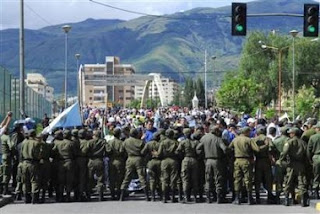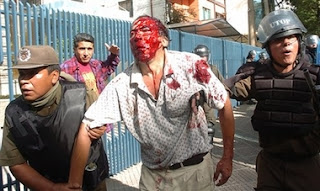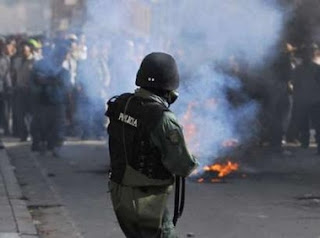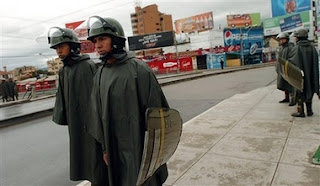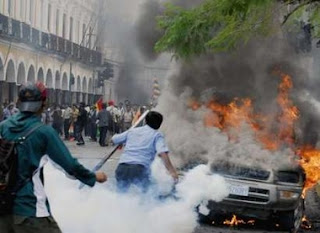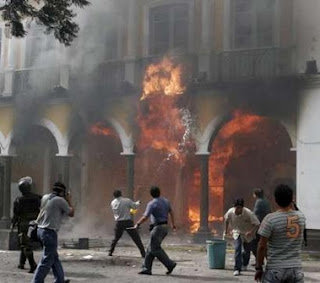I have complied a FAQ on what is going on in Cochabamba, Bolivia. If you missed the genesis of the conflict, you will be able to catch up, while more news appear in the media.
How did the conflict start?
On December 14
th, 2006, a day before the Crescent Moon Departments (Santa Cruz,
Tarija,
Beni and
Pando, which form a crescent moon shape in Bolivia's map) organized a mass protest against
Evo Morales' intrusion in the Constituent Assembly (
here), Cochabamba Governor
Mafred Reyes Villa also organized a town hall meeting. In this meeting, he expressed support for the Crescent Moon call for autonomy and 2/3 in the Constituent Assembly. He also said that he would call for a new autonomy referendum in Cochabamba, as he considers that population was misinformed during the July 2006 one, when Cochabamba rejected autonomy with 63%.
On January 4
th, the "social movements" aligned with MAS decide to ask for Reyes Villa's resignation for 'treason'. The aforementioned social movements are comprised by only 6 of 35 social groups of Cochabamba's Workers' Union (COD). All of them are Coca Growers Unions, which are incidentally commanded by
Evo Morales.
On the 5
th they start the siege of Cochabamba. No violence is registered thus far and Reyes Villa says he will not resign.
On January 8
th, things get out of hand. The "social movements" start getting violent. Cabinet member Alicia Munoz orders the police not to intervene -because it would be repression. Commanded by MAS legislators, the movements set the Cochabamba State Capitol on fire (
here). The government is quick to
denounce Cochabamba's Governor as the main culprit, while
acknowledging that it was their
grassroots movements who set the building on fire. Newspapers report that Governor Reyes Villa had to evacuate the building disguised in a fire truck.
On January 9
th,
Evo Morales censors minister Alicia Munoz and travels to Nicaragua, leaving Vice-President Garcia
Linera in charge. Bolivian police is confused in regard to what their function should be. Garcia
Linera supports the
cocaleros and says that Manfred Reyes Villa's call for a referendum is illegal.
Cocaleros start blocking the roads of Cochabamba, causing at least $3 million in loses for exporters and thousands of stranded travellers. Civic Committee calls for a 'march for peace' to be held in one of Cochabamba's main squares.
On
Janury 10
th, the
cocaleros take over the square
designated for the Committee's march. People from Cochabamba, tired from the excesses of
cocaleros, reunite somewhere else and start marching towards the
cocaleros. There is no violence, but the Civic group, called Youth for Democracy, give 24 hrs to the
cocaleros to leave town. Anti-
Evo chants can be heard on one side of the street (
Evo,
Cuidado, El Pueblo Esta
Emputado -
Evo, be careful, the people are pissed off) and Anti-Autonomy chants on the other (
Autonomia,
Nunca,
Carajo! - Autonomy, fucking never!).
Secreary of Cochabamba's COD admits that most social groups are not taking part in the protests and that they screwed up (
metieron la
pata) by demanding Reyes Villa's resignation (
here). The Governor of La
Paz supports Reyes Villa and proposes that the autonomy referendum be nationwide (
here). Santa Cruz and the Crescent Moon departments express their support for Manfred Reyes Villa and democracy. Garcia
Linera says that the government will retreat its forces
iff Reyes Villa does not call the autonomy referendum (
here).
Cocaleros put two people in hospital, just because
they had Eastern Bolivia accents. They also get violent with
reporters (
here and here).
This chain of events leads to...
What happened yesterday?Youth for Democracy (
YfD) get together again and give one more warning to the
cocaleros: they have until 3pm to get out of Cochabamba. Once the deadline passes, a force of 8,000-10,000 start marching to the site where
cocaleros are posted. There is a small police force in the
Cala-
Cala Bridge, but they are easily and non-violently surpassed. They arrive to the
Banderas Square, where
cocaleros are surprised and flee to the Prado avenue. Violent clashes are registered, and the
YfD follow the
cocaleros. There are more
cocaleros waiting in the Prado avenue and chaos takes over.
Cocaleros throw
dynamite to the
YfD and some
gunshots are heard, although most battles resort to sticks, fists and stones (
here). 400 policemen/women are deployed to deal with the conflict (
here).
Reyes Villa is in La
Paz, in a meeting with all non-
aligned Governors. This, unfortunately leads to MAS pressure groups getting together and starting the conflict in La
Paz. They are maintaining a siege of the hotel where the elected officials are meeting and issued orders to take over the international airport, in order to prevent the Governors from getting out or support from coming in (
here). Reports of food scarcity in La
Paz and Cochabamba appear. Santa Cruz is also in alert and preparing to support Reyes Villa and Democracy (
here).
MAS Vice-President says that all 4 members of
YfD caught with guns will be processed.
Surprisingly, he does not say a word about what will happen to
cocaleros caught with guns or
dynamite (
here).
What is the toll of the conflict so far?SO far, two people have died and more than 100 are wounded, 3 of which are fighting for their lives as of now. Other media outlets report more than 200 wounded and one person with cerebral death.
The dead are:
16 year old Cristian
Urresti, from the
YfD. Death was caused by several machete wounds to the head. He was the son of a LAB pilot and his 17
th birthday was today.
41 year old
Nicomedes Gutierrez, from the
cocaleros. Death was caused by a bullet wound to the chest.
Some media have reported a third death, but it is unconfirmed as of now. The wounded are aged from 12 to 65, on both sides. The majority of injured belongs to the
cocaleros, though.
Only 400 policemen/women to control 10,000 persons? Yes. The crisis in the police was caused by cabinet member Alicia Munoz. When police was disbanding violent attacks from
cocaleros with tear gas on Jan. 8
th, she sacked the newly appointed police chief for repression. The police retreated and the
cocaleros were able to burn the State Capitol. She also said that "when the minister is in charge, no governor is [in charge] (
Donde manda ministra, no
manda prefecto)", making police men and women fear for their jobs if they acted. It is clear now that police acted on their own and were just doing their jobs, i.e. protecting the city. Reyes Villa and the sacked chief of police deny giving orders. So, it is likely that police officials are reluctant to act for fear to MAS' apparatus.
Is it likely for the conflict to spread to other regions?The
conflict has already spread to La
Paz and Santa Cruz (
here).
What is Evo Morales doing to solve this conflict?Nothing.
Evo Morales is not even in Bolivia, he's in Nicaragua with Hugo Chavez, celebrating former dictator Daniel Ortega's return to power. His trip was not authorized by Congress, so his visit to Ortega should be considered personal and not official. He travelled one day after the Cochabamba state capitol was burnt by his followers, which indicates where his priorities lie.
You are lying because you are a damn oligarch. Evo Morales is the Messiah.No, he's not. He's a very naughty boy.
So, who is responsible for this conflict taking place?So far, instead of trying to
apace the sides, both government and opposition have been busy trying to make the other look bad.
However, if you view things impartially, the government should be held responsible. First, they are the ones that organized the
cocaleros and send them to to Cochabamba. If the government were somewhat more democratically-oriented, they would not have panicked from Reyes Villa referendum call. But, since it was with street protests that
Evo Morales got into power, they were keen to use it whenever somebody said something they didn't like. They certainly did not count with people going to the streets to defend democracy and react to their burning of the State Capitol. The view of many
cocaleros is "if we could oust [former president] Sanchez
de Lozada, we can oust Reyes Villa". Once again, this shows
Evo Morales' authoritarian leanings.
Second, it was
Evo Morales, through years of complaining about state repression against the will of the people, who took away the state's monopoly on violence. Now, MAS officials are too busy trying to look like good guys, opposed to repression, to make the police enforce the law. Now, anybody (who is aligned to MAS) can do
anything and if the police tries to prevent it, we soon hear cries of human rights violations and police repression, regardless of how legal the act was in the first place.
Finally, MAS started the conflict, by burning the State Capitol and, instead of calling a truce, blaming the Governor. This was too much for
Cochabambinos.
I hear several statements saying that the autonomy referendum proposed by Manfred Reyes Villa is illegal. Is this true?No. The referendum called by Manfred Reyes Villa is totally legal. This has been confirmed by the country's electoral body (
here). In fact, any citizen in Bolivia who can come up with the necessary number of signatures and agrees to pay the costs, can organize a referendum. The legality of the referendum has been questioned by MAS officials and used as a pretext to sack a democratically-elected Governor who is aligned with the opposition. MAS fears that if Cochabamba wins its autonomy, other departments will follow soon and this will be a fatal blow to
Evo's wishes of pulling a Chavez -he's trying to increase his power by writing a new constitution.
What is the international community saying about this conflict?Not much. Yesterday at 7pm GMT, I looked into the BBC (UK's international edition),
UK's newspapers The Independent, The Guardian, The Times, The Financial Times and the Telegraph, Spain's El
Pais and US' NY Times and
WSJ and none had a word about it. None of them even had the Capitol Burning piece. The papers I found to report the incident were the Miami Herald and SF Chronicle. Today, it seems that BBCMundo (in Spanish), El
Pais, the NY Times and Washington Post have started following the conflict. No UK newspapers have done so until now.
In terms of blogs, read Manuel
Buitrago's MABB and
Publius Pundit (links are on the side bar).
Where can I read updates on the situation?If you can read Spanish,
La Razon from La
Paz and
Los Tiempos from Cochabamba are the newspapers I follow, although
el Deber, from Santa Cruz may become a very interesting read now.
They only make a couple of updates a day, though. A better website, with more frequent updates, is that of
NoticiasBolivianas.com. It also includes the headlines for all Bolivian newspapers.
For English readers, keep an eye on the blogs I mention above and this one.
Bolivia,
Bolivien,
Evo,
Evo Morales,
Labels: Bolivia, Civil War, Cochabamba, Evo Morales



